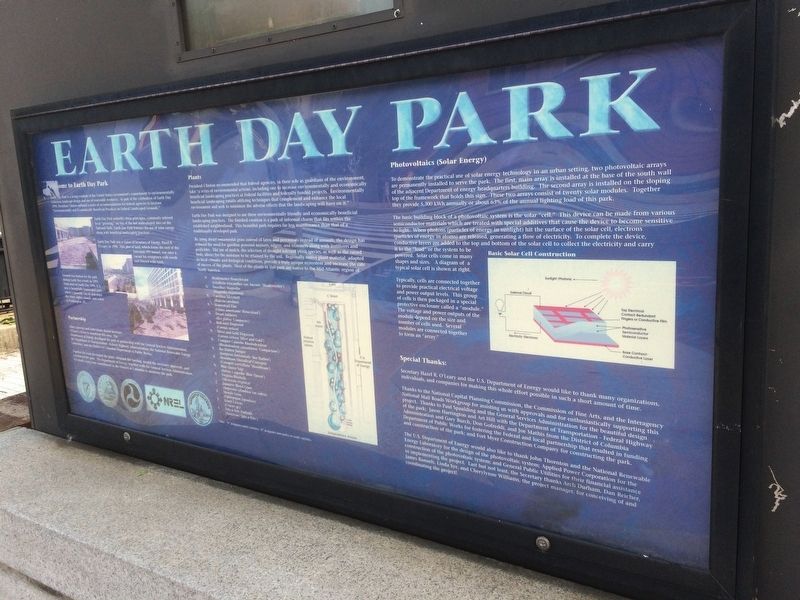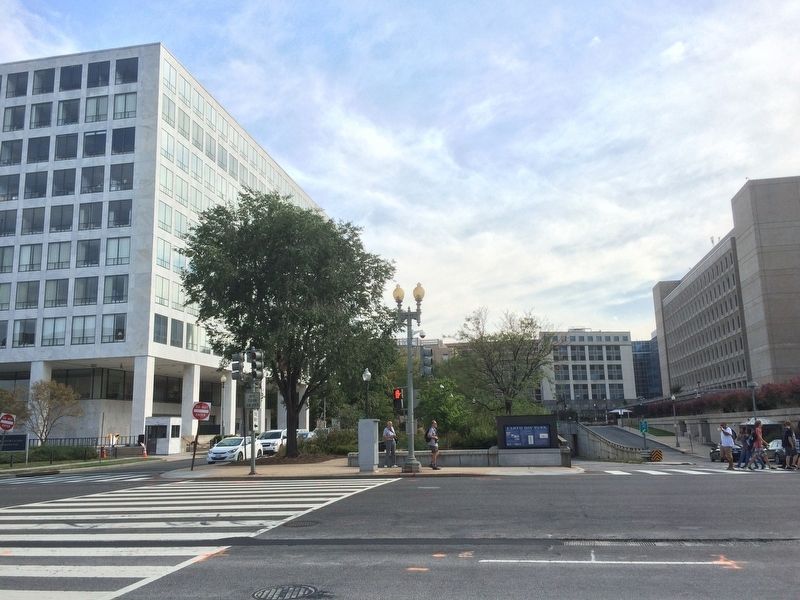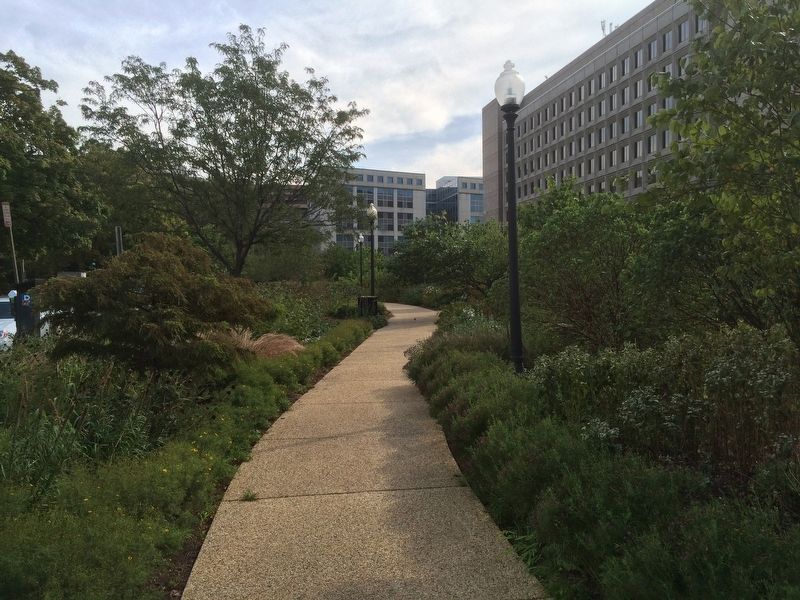Southwest Federal Center in Southwest Washington in Washington, District of Columbia — The American Northeast (Mid-Atlantic)
Earth Day Park
Welcome to Earth Day Park
Earth Day Park is a living example of the United States Government’s commitment to environmentally conscious landscape design and use of renewable resources. As part of the celebration of Earth Day 1994, President Clinton outlined a series of recommendations for federal agencies to increase “Environmentally and Economically Beneficial Practices on Federal Landscaped Grounds.”
Earth Day Park embodies these principles, commonly referred to as “greening,” on one of the last undeveloped sites on the National Mall. Earth Day Park features the use of solar energy along with beneficial landscaping practices.
Earth Day Park was a vision of Secretary of Energy, Hazel R. O’Leary, in 1994. This plot of land, which forms the roof of the Interstate-395 tunnel, was once a vacant lot overgrown with weeds and littered with trash.
Ground was broken for the park during Earth Day events in 1995. Dedicated on Earth Day 1996, it is now a beautifully landscaped park where a passerby can sit and enjoy the many sights, sounds and colors of Washington, DC.
Many agencies and individuals shared Secretary O’Leary’s vision to transform this area. The Department of Energy developed the park in partnership with the General Services Administration, the Department of Transportation – Federal Highway Administration, the National Renewable Energy Laboratory, and the District of Columbia Department of Public Works.
Together the team developed the plans, obtained the funding, sought the necessary approvals, and constructed the park. The Department of Energy, together with the General Services Administration, have made a long term commitment to the District of Columbia to maintain the park.
Plants
President Clinton recommended that federal agencies, in their role as guardians of the environment, take “a series of environmental actions, including one to increase environmentally and economically beneficial landscaping practices at Federal facilities and federally funded projects. Environmentally beneficial landscaping entails utilizing techniques that complement and enhance the local environment and seek to minimize the adverse effects that the landscaping will have on it.”
Earth Day Park was designed to use these environmentally friendly and economically beneficial landscaping practices. The finished creation is a park of informal charm that fits within the established neighborhood. This beautiful park requires far less maintenance that that of a traditionally developed park.
By using dwarf ornamental grass instead of lawn and perennials instead of annuals, the design has reduced the need for gasoline powered mowers, edgers, and trimmers
along with fertilizers and pesticides. The use of mulch, the selection of drought tolerant species, as well as the raised beds, allows for the moisture to be retained by the soil. Regionally native plant material, adapted to local climatic and biological conditions, provide a truly unique ecosystem and increase the rate of success of the plants. Most of the plants in this park are native to the Mid-Atlantic region of North America.
Photovoltaics (Solar Energy)
To demonstrate the practical use of solar energy technology in an urban setting, two photovoltaic arrays are permanently installed to serve the park. The first, main array is installed at the base of the south wall of the adjacent Department of energy headquarters building. The second array is installed on the sloping top of the framework that holds this sign. These two arrays consist of twenty solar modules. Together they provide 5,300 kWh annually or about 63% of the annual lighting load of this park.
The basic building block of a photovoltaic system is the solar “cell.” This device can be made from various semiconductor materials which are treated with special additives that cause the device to become sensitive to light. When photons (particles of energy in sunlight) hit the surface of the solar cell, electrons (particles of energy in atoms) are released, generating a flow of electricity. To complete
the device, conductive layers are added to the top and bottom of the solar cell to collect the electricity and carry it to the “load” or the system to be powered. Solar cells come in many shapes and sizes. A diagram of a typical solar cell is shown at right.
Typically, cells are connected together to provide practical electrical voltage and power output levels. This group of cells is then packaged in a special protective enclosure called a “module.” The voltage and power outputs of the module depend on the size and number of cells used. Several modules are connected together to form an “array.”
Special Thanks: Secretary Hazel R. O’Leary and the U.S. Department of Energy would like to thank many organizations, individuals, and companies for making this whole effort possible in such a short amount of time. Thanks to the National Capital Planning Commission, the Commission of Fine Arts, and the Interagency National Mall Roads Workgroup for assisting us with approvals and for enthusiastically supporting this project. Thanks to Paul Spaulding and the General Services Administration for the beautiful design of the park; Jason Harrington and Art Hill with the Department of Transportation – Federal Highway Administration and Gary Burch, Don Gofreddi, and Joe Mathis from the District of Columbia Department of Public Works for fostering the Federal and local partnership that resulted in funding and construction of the park; and Fort Myer Construction Company for constructing the park. The U.S. Department of Energy would also like to thank John Thornton and the National Renewable Energy Laboratory for the design of the photovoltaic system; Applied Power Corporation for the construction of the photovoltaic system; and General Public Utilities for their financial assistance in implementing the project. Last but not least, the Secretary thanks Arch Durham, Dan Reicher, James Rannels, Linda Sye, and Cherylynne Williams, the project manager, for conceiving of and coordinating the project!
Erected 1996 by U.S. Department of Energy; U.S. General Services Administration.
Topics and series. This historical marker is listed in these topic lists: Environment • Horticulture & Forestry • Parks & Recreational Areas. In addition, it is included in the Former U.S. Presidents: #42 William Jefferson "Bill" Clinton series list. A significant historical year for this entry is 1994.
Location. This marker has been replaced by another marker nearby. It was located near 38° 53.246′ N, 77° 1.443′ W. Marker was in Southwest Washington in Washington, District of Columbia. It was in Southwest Federal Center. Marker was on Independence Avenue Southwest east of 9th Street Southwest, on the right when traveling east. Touch for map. Marker was in this post office area: Washington DC 20591, United States of America. Touch for directions.
Other nearby markers. At least 8 other markers are within walking distance of this location. A different marker also named Earth Day Park (here, next to this marker); Pumpkin, 2016 (about 300 feet away, measured in a direct line); Enid A. Haupt Garden (about 300 feet away); Before the National Air and Space Museum opened (about 400 feet away); A Common Language (about 500 feet away); Spencer Fullerton Baird (about 500 feet away); Welcome to the Smithsonian's Arts + Industries Building (about 500 feet away); The Slave Trade in Washington, DC (about 500 feet away). Touch for a list and map of all markers in Southwest Washington.
More about this marker.
Captions:
N Shademaster Honeylocust (Gleditsia triacanthos var. inermis ‘Shademaster’) · N Sweetbay Magnolia (Magnolia virginiana) · N Carolina Sweetbell (Halesia carolina) · N Homestead Elm (Ulmus americana ‘Homestead’) · N Dwarf Inkberry (Ilex glabra ‘Compacta’) · N Red-osier Dogwood (Cornus sericea) · N Silver and Gold Dogwood (Cornus sericea ‘Silver and Gold’) · N Compact Catawba Rhododendron (Rhododendron catawbiense ‘Compactum’) · N Bar Harbor Juniper (Juniperus horizantalis ‘Bar Harbor’) · N Moonbeam Threadleaf Coreopsis (Coreopsis verticillata ‘Moonbeam’) · Blue Queen Sage (Salvia x superba ‘Blue Queen’) · N Virginia Bluebells (Metensia virginica) · E Japanese Blood Grass (Imperata cylindrical var. rubra) · E Mondo Grass (Ophiopogon japonicus) · E Giant Crocus (Crocus sp.) · E Tete-a-Tete Daffodil (Narcissus ‘Tete-a-Tete’)
Note: “N” designates native varieties, “E” designates non-native or exotic varieties.
Basic Solar Cell Construction
Related marker. Click here for another marker that is related to this marker. This marker has been replaced by the linked marker.
Credits. This page was last revised on January 30, 2023. It was originally submitted on November 3, 2016, by J. Makali Bruton of Accra, Ghana. This page has been viewed 397 times since then and 15 times this year. Photos: 1, 2, 3. submitted on November 3, 2016, by J. Makali Bruton of Accra, Ghana.


